Askeland D.R., Fulay P.P. Essentials of Materials Science & Engineering
Подождите немного. Документ загружается.

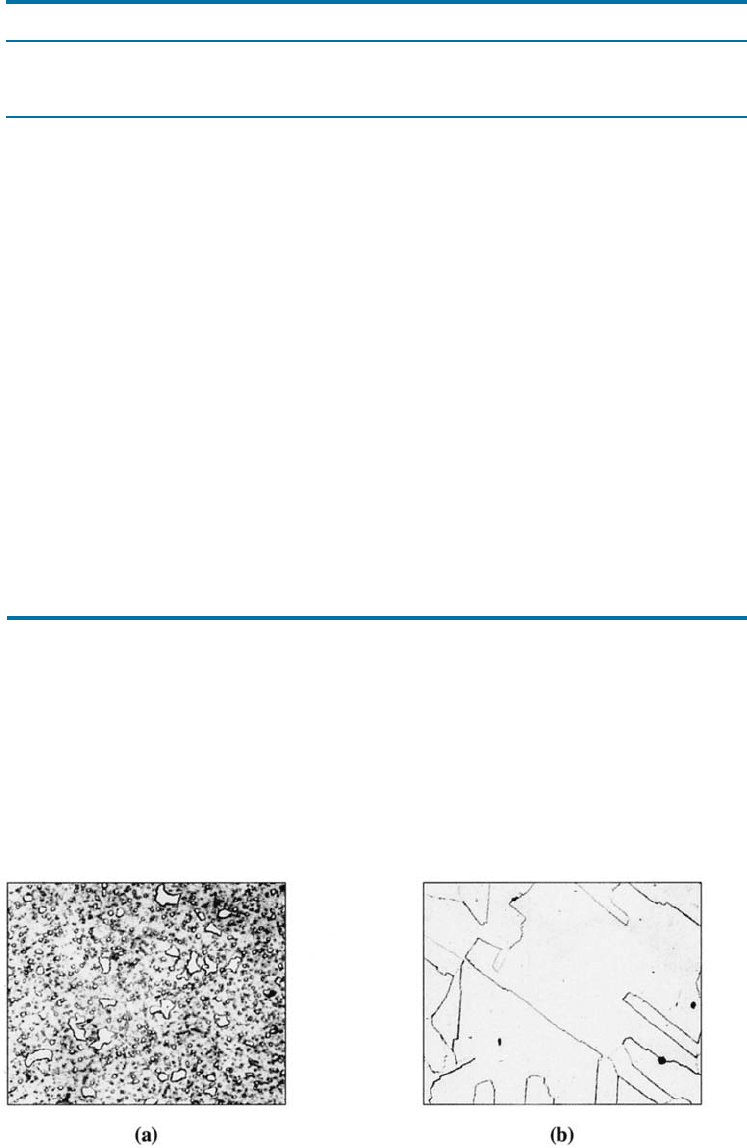
hardnesses to be produced. The combination of hardness, strength, and corrosion re-
sistance makes the alloys attractive for applications such as high-quality knives, ball
bearings, and valves.
Austenitic Stainless Steels Nickel, which is an austenite stabilizing element , increases
the size of the austenite field, while nearly eliminating ferrite from the iron-chromium-
carbon alloys [Figure 13-28(b)]. If the carbon content is below about 0.03%, the car-
TABLE 13-4 9 Typical compositions and properties of stainless steels
Steel % C % Cr % Ni Others
Tensile
Strength
(MPa)
Yield
Strength
(MPa)
%
Elongation Condition
Austenitic:
201 0.15 17 5 6.5% Mn 655 310 40 Annealed
304 0.08 19 10 517 207 30 Annealed
1276 965 9 Cold-worked
304L 0.03 19 10 517 207 30 Annealed
316 0.08 17 12 2.5% Mo 517 207 30 Annealed
321 0.08 18 10 0.4% Ti 586 241 55 Annealed
347 0.08 18 11 0.8% Nb 621 241 50 Annealed
Ferritic:
430 0.12 17 448 207 22 Annealed
442 0.12 20 517 276 20 Annealed
Martensitic:
416 0.15 13 0.6% Mo 1241 965 18 Quenched and
tempered
431 0.20 16 2 1379 1034 16 Quenched and
tempered
440C 1.10 17 0.7% Mo 1965 1896 2 Quenched and
tempered
Precipitation hardening:
17-4 0.07 17 4 0.4% Nb 1310 1172 10 Age-hardened
17-7 0.09 17 7 1.0% Al 1655 1586 6 Age-hardened
Figure 13-29 (a) Martensitic stainless steel containing large primary carbides and small
carbides formed during tempering (350). (b) Austenitic stainless steel (500). (From ASM
Handbook, Vols. 7 and 8, (1972, 1973), ASM International, Materials Park, OH 44073.)
C HA P T E R 1 3 Heat Treatment of Steels and Cast Irons420

bides do not form and the steel is virtually all austenite at room temperature [Figure
13-29(b)].
The FCC austenitic stainless steels have excellent ductility, formability, and cor-
rosion resistance. Strength is obtained by extensive solid-solution strengthening, and the
austenitic stainless steels may be cold worked to higher strengths than the ferritic
stainless steels. These are nonmagnetic, which is an advantage for many applications.
For example, as seen in Chapter 12, cardiovascular stents are often made from 316
stainless steels. The steels have excellent low-temperature impact properties, since they
have no transition temperature. Furthermore, the austenitic stainless steels are not fer-
romagnetic. Unfortunately, the high-nickel and chromium contents make the alloys
expensive. The 304 alloy containing 18% Cr and 8% nickel (also known as 18-8 stain-
less) is the most widely used grade of stainless steel. Although stainless, this alloy can
undergo sensitization. When heated to a temperature of @480 to 860
C, chromium
carbides precipitate along grain boundaries rather than within grains. This causes
chromium depletion in the interior of the grains and this will cause the stainless steel to
corrode very easily. This is known as sensitization.
Precipitation-Hardening (PH) Stainless Steels The precipitation-hardening (or PH)
stainless steels contain Al, Nb, or Ta and derive their properties from solid-solution
strengthening, strain hardening, age hardening, and the martensitic reaction. The steel is
first heated and quenched to permit the austenite to transform to martensite. Reheating
permits precipitates such as Ni
3
Al to form from the martensite. High-mechanical
properties are o btained even with low-carbo n con tents.
Duplex Stainless Steels In some cases, mixtures of phases are deliberately introduced
into the stainless steel structure. By appropriate control of the composition and heat
treatment, a duplex stainless steel containing approximately 50% ferrite and 50% aus-
tenite can be produced. This combination provides a set of mechanical properties, cor-
rosion resistance, formability, and weldability not obtained in any one of the usual
stainless steels.
Stainless steels are recyclable, and the following example shows how di¤erences in
properties can be used to separate di¤erent types of stainless steels.
EXAMPLE 13-10
Design of a Test to Separate Stainless Steels
In order to e‰ciently recycle stainless steel scrap, we wish to separate the high-
nickel stainless steel from the low-nickel stainless steel. Design a method for
doing this.
SOLUTION
Performing a chemical analysis on each piece of scrap is tedious and expensive.
Sorting based on hardness might be less expensive; however, because of the
di¤erent types of treatments—such as annealing, cold working, or quench and
tempering—the hardness may not be related to the steel composition.
The high-nickel stainless steels are ordinarily austenitic, whereas the low-
nickel alloys are ferritic or martensitic. An ordinary magnet will be attracted to
the low-nickel ferritic and martensitic steels, but will not be attracted to the
high-nickel austenitic steel. We might specify this simple and inexpensive mag-
netic test for our separation process.
13-10 Stainless Steels 421
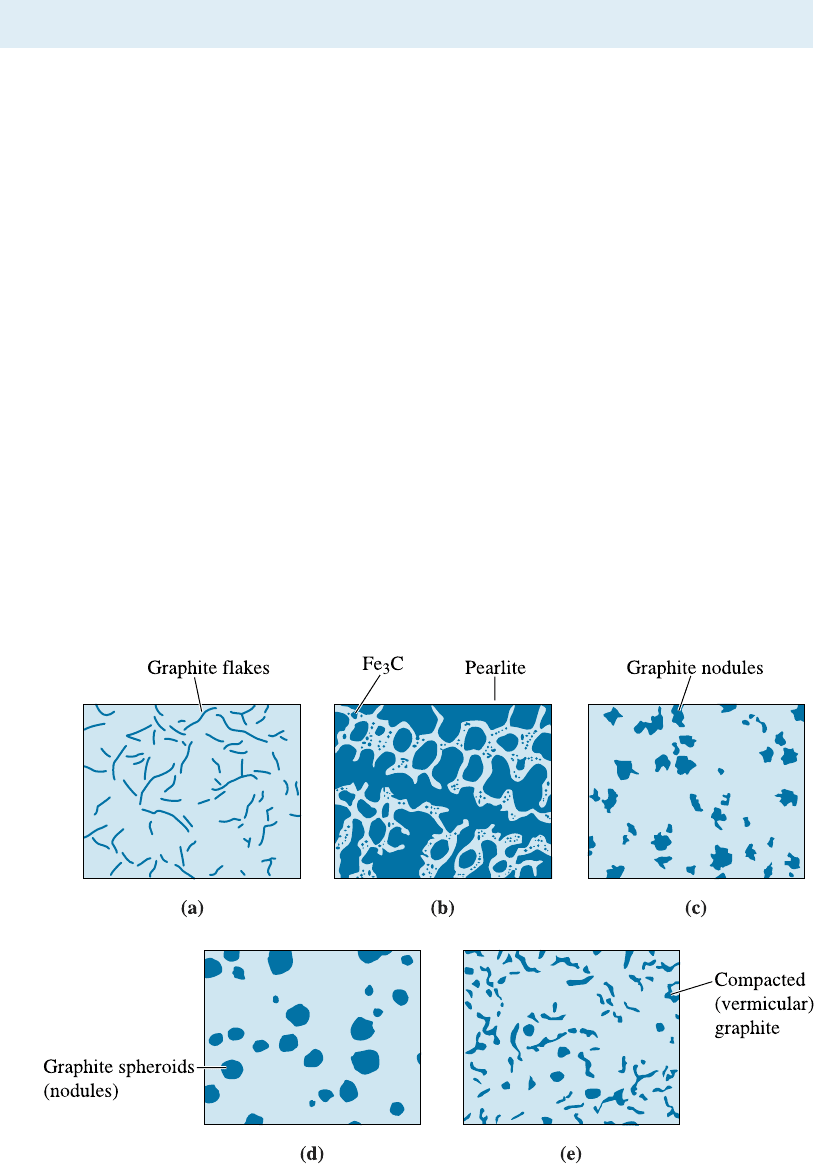
13-11 Cast Irons
Cast irons are iron-carbon-silicon alloys, typically containing 2–4% C and 0.5–3% Si,
that pass through the eutectic reaction during solidification. The microstructures of the
five important types of cast irons are shown schematically in Figure 13-30.
Eutectic Reaction in Cast Irons Based on the Fe-Fe
3
C phase diagram (dashed lines in
Figure 13-31), the eutectic reaction that occurs in Fe-C alloys at 1140
C is:
L ! g þ Fe
3
C ð13-1Þ
This reaction produces white cast iron, with a microstructure composed of Fe
3
C and
pearlite (formed by the decomposition of austenite). The Fe-Fe
3
C system, however, is
really a metastable phase diagram. Under truly equilibrium conditions, the eutectic
reaction is:
L ! g þ graphite ð13-2Þ
The Fe-C phase diagram is shown as solid lines in Figure 13-31. When the stable L !
g þ graphite eutectic reaction occurs at 1146
C, gray, ductile, or compacted-graphite
cast iron forms.
In Fe-C alloys, the liquid easily undercools 6
C (the temperature di¤erence between
the stable and metastable eutectic temperatures) and white iron forms. Adding about
2% silicon to the iron increases the temperature di¤erence between the eutectics, per-
mitting larger undercoolings to be tolerated and more time for the stable graphite
eutectic to nucleate and grow. Silicon, therefore, is a graphite stabilizing elemen t. Ele-
ments such as chromium and bismuth have the opposite e¤ect and encourage white cast
Figure 13-30 Schematic drawings of the five types of cast iron: (a) gray iron, (b) white iron,
(c) malleable iron, (d) ductile iron, and (e) compacted graphite iron.
C HA P T E R 1 3 Heat Treatment of Steels and Cast Irons422
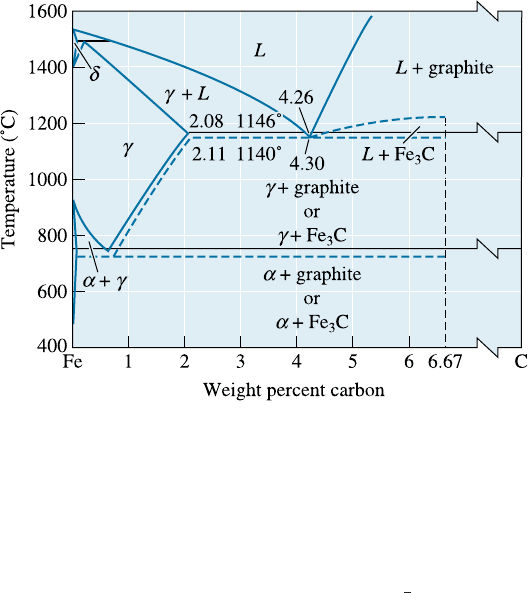
iron. We can also introduce inoculants, such as silicon (as Fe-Si ferrosilicon), to
encourage the nucleation of graphite, or we can reduce the cooling rate of the casting to
provide more time for the growth of graphite.
Silicon also reduces the amount of carbon contained in the eutectic. We can take
this e¤ect into account by defining the carbon equivalent (CE):
CE ¼ %Cþ
1
3
%Si ð13-3Þ
The eutectic composition is always near 4.3% CE. A high-carbon equivalent encourages
the growth of the graphite eutectic.
Eutectoid Reaction in Cast Irons The matrix structure and properties of each type of
cast iron are determined by how the austenite transforms during the eutectoid reaction.
In the Fe-Fe
3
C phase diagram used for steels, the austenite transformed to ferrite and
cementite, often in the form of pearlite. However, silicon also encourages the stable
eutectoid reaction:
g ! a þ graphite ð13-4Þ
Under equilibrium conditions, carbon atoms di¤use from the austenite to existing
graphite particles, leaving behind the low-carbon ferrite. The transformation diagram
(Figure 13-32) describes how the austenite might transform during heat treatment.
Annealing (or furnace cooling) of cast iron gives a soft ferritic matrix (not coarse pear-
lite as in steels!). Normalizing, or air cooling, gives a pearlitic matrix. The cast irons can
also be austempered to produce bainite, or can be quenched to martensite and tem-
pered. Austempered ductile iron, with strengths of up to 1379 MPa, is used for high-
performance gears.
Gray cast iron contains small, interconnected graphite flakes that cause low strength
and ductility. This is the most widely used cast iron and is named for the dull gray color
of the fractured surface. Gray cast iron contains many clusters, or eutectic cells, of in-
terconnected graphite flakes (Figure 13-33). The point at which the flakes are connected
is the original graphite nucleus. Inoculation helps produce smaller eutectic cells, thus
improving strength. The gray irons are specified by a class number of 20 to 80. A class
20 gray iron has a nominal tensile strength of 138 MPa. In thick castings, however,
Figure 13-31
The iron-carbon phase
diagram showing the
relationship between
the stable iron-graphite
equilibria (solid lines)
and the metastable iron-
cementite reactions
(dashed lines).
13-11 Cast Irons 423

coarse graphite flakes and a ferrite matrix produce tensile strengths as low as 83 MPa
(Figure 13-34), whereas in thin castings, fine graphite and pearlite form and give tensile
strengths near 276 MPa. Higher strengths are obtained by reducing the carbon equiv-
alent, by alloying, or by heat treatment. The graphite flakes concentrate stresses and
cause low strength and ductility, but gray iron has a number of attractive properties,
including high compressive strength, good machinability, good resistance to sliding
wear, good resistance to thermal fatigue, good thermal conductivity, and good vibration
damping.
White cast iron is a hard, brittle al loy containing massive amounts of Fe
3
C. A
fractured surface of this material appears white, hence the name. A group of highly
alloyed white irons are used for their hardness and resistance to abrasive wear. Ele-
ments such as chromium, nickel, and molybdenum are added so that, in addition to the
alloy carbides formed during solidification, martensite is formed during subsequent heat
treatment.
Figure 13-32
The transformation
diagram for austenite in a
cast iron.
Figure 13-33 (a) Sketch and (b) photomicrograph of the flake graphite in gray cast iron
(100).
C HA P T E R 1 3 Heat Treatment of Steels and Cast Irons424
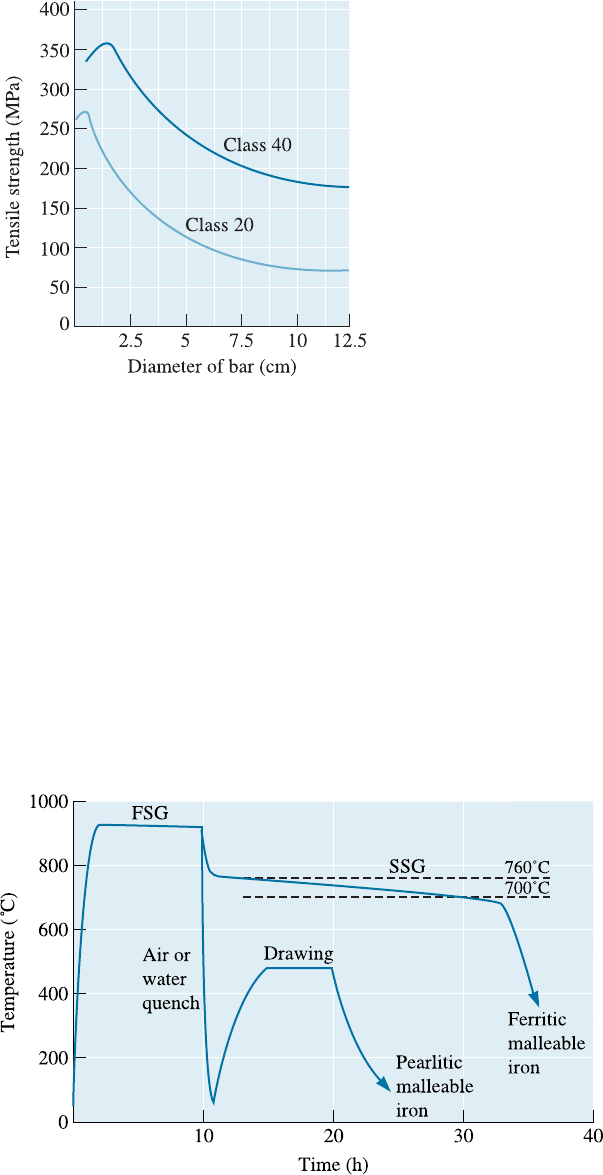
Malleable cast iron, formed by the heat treatment of white cast iron, produces
rounded clumps of graphite. It exhibits better ductility than gray or white cast irons. It is
also very machinable. Malleable iron is produced by heat treating unalloyed 3% carbon
equivalent (2.5% C, 1.5% Si) white iron. During the malleabilizing heat treatment, the
cementite formed during solidification is decomposed and graphite clumps, or nodules,
are produced. The nodules, or temper carbon, often resemble popcorn. The rounded
graphite shape permits a good combination of strength and ductility. The production of
malleable iron requires several steps (Figure 13-35). Graphite nodules nucleate as the
white iron is slowly heated. During first stage graphitization (FSG), cementite decom-
poses to the stable austenite and graphite phases as the carbon in Fe
3
C di¤uses to the
graphite nuclei. Following FSG, the austenite transforms during cooling. Figure 13-36
shows the microstructures of the original white iron (a) and the two types of malleable
iron that can be produced (b and c). To make ferritic malleable iron, the casting is cooled
Figure 13-34
The effect of the cooling rate or casting size
on the tensile properties of two gray cast
irons.
Figure 13-35 The heat treatments for ferritic and pearlitic malleable irons.
13-11 Cast Irons 425
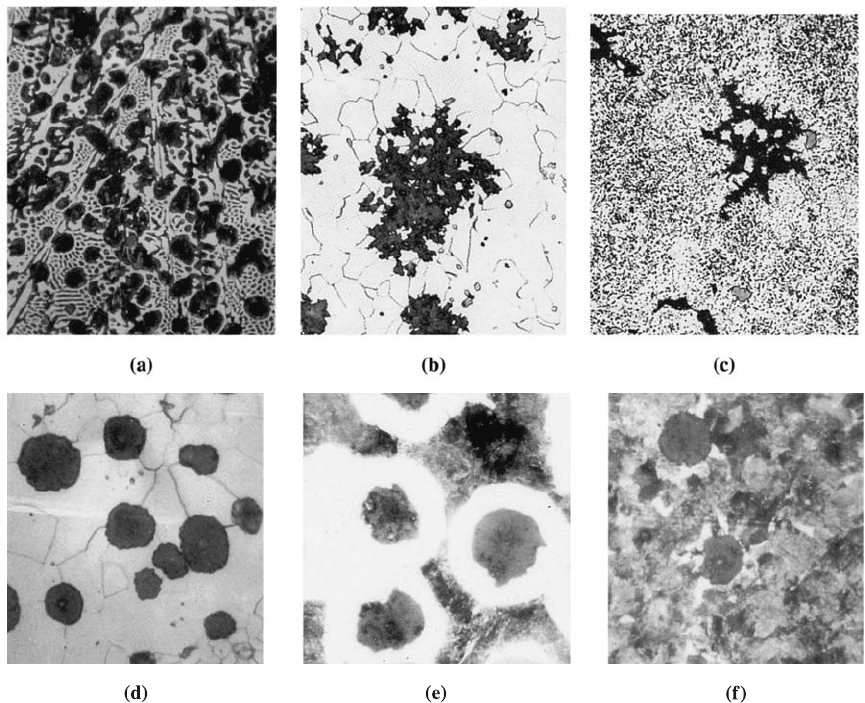
slowly through the eutectoid temperature range to cause second stage graphitization
(SSG). The ferritic malleable iron has good toughness compared with that of other irons
because its low-carbon equivalent reduces the transition temperature below room tem-
perature. Pearlitic malleable iron is obtained when austenite is cooled in air or oil to
form pearlite or martensite. In either case, the matrix is hard and brittle. The iron is then
drawn at a temperature below the eutectoid. Drawing tempers the martensite
or spheroidizes the pearlite. A higher drawing temperature decreases strength and
increases ductility and toughness.
Ductile (or nodular) cast iron contains spheroidal graphite particles. Ductile iron is
produced by treating liquid iron with a carbon equivalent of near 4.3% with magne-
sium, which causes spheroidal graphite (called nodules) to grow during solidification,
rather than during a lengthy heat treatment. Several step s are required to produce this
iron. These include desulfurization, nodulizing, and inoculatio n. In desulfurization, any
sulfur and oxygen in the liquid metal is removed by adding desulfurizing agents such as
Figure 13-36 (a) White cast iron prior to heat treatment (100). (b) Ferritic malleable iron
with graphite nodules and small MnS inclusions in a ferrite matrix (200). (c) Pearlitic
malleable iron drawn to produce a tempered martensite matrix (500). (Images (b) and (c)
are from Metals Handbook, Vols. 7 and 8, (1972, 1973), ASM International, Materials Park,
OH 44073.) (d) Annealed ductile iron with a ferrite matrix (250). (e) As-cast ductile iron with
a matrix of ferrite (white) and pearlite (250). (f) Normalized ductile iron with a pearlite matrix
(250).
C HA P T E R 1 3 Heat Treatment of Steels and Cast Irons426

calcium oxide (CaO). In nodulizing, Mg is added, usually in a dilute form such as an
MgFeSi alloy. If pure Mg is added , the nodulizing reaction is very violent, since the
boiling point of Mg is much lower than the temperature of the liquid iron, and most of
the Mg will be lost. A residual of about 0.03% Mg must be in the liquid iron after
treatment in order for spheroidal graphite to grow. Finally, inoculation with FeSi com -
pounds to cause heterogeneous nucleation of the graphite is essential; if inoculation is
not e¤ective, white iron will form instead of ductile iron. The nodulized and inoculated
iron must then be poured into molds within a few minutes to avoid fading. Fading oc-
curs by the gradual, nonviolent loss of Mg due to vaporization and/or reaction with
oxygen, resulting in flake or compacted graphite instead of spheroidal graphite. In ad-
dition, the inoculant e¤ect will also fade, resulting in white iron.
Compared with gray iron, ductile cast iron has excellent strength and ductility.
Due to the higher silicon content (typically around 2.4%) in ductile irons compared with
1.5% Si in malleable irons, the ductile irons are stronger but not as tough as malleable
irons.
Compacted-graphite cast iron contains rounded but interconnected graphite also
produced during solidification. The graphite shape in compacted-graphite cast iron is
intermediate between flakes and spheres, with numerous rounded rods of graphite that
are interconnecte d to the nucleus of the eutectic cell. This compacted graphite, some-
times called vermicular graphite, also forms when ductile iron fades. The compacted
graphite permits strengths and ductilities that exceed those of gray cast iron, but allows
the iron to retain good thermal conductivity and vibration damping properties. The
treatment for the compacted-graphite iron is similar to that for ductile iron; however,
only about 0.015% Mg is introduced during nodulizing. A small amount of titanium
(Ti) is added to assure the formation of the compacted graphite.
Typical properties of cast irons are given in Table 13-5.
TABLE 13-5 9 Typical properties of cast irons
Tensile
Strength
(MPa)
Yield
Strength
(MPa) % E Notes
Gray irons:
Class 20 83–276 — —
Class 40 193–372 — —
Class 60 303–455 — —
Malleable irons:
32510 345 224 10 Ferritic
35018 365 241 18 Ferritic
50005 483 345 5 Pearlitic
70003 586 483 3 Pearlitic
90001 724 621 1 Pearlitic
Ductile irons:
60–40–18 414 276 18 Annealed
65–45–12 448 310 12 As-cast ferritic
80–55–06 552 379 6 As-cast pearlitic
100–70–03 689 483 3 Normalized
120–90–02 827 621 2 Quenched and tempered
Compacted-graphite irons:
Low strength 276 193 5 90% Ferritic
High strength 448 379 1 80% Pearlitic
13-11 Cast Irons 427

SUMMARY V The properties of steels, determined by dispersion strengthening, depend on the
amount, size, shape, and distribution of cementite. These factors are controlled by
alloying and heat treatment.
V A process anneal recrystallizes cold-worked steels and reduces stresses.
V Spheroidizing produces large, spheroidal Fe
3
C and good machinability in high-
carbon steels.
V Annealing, involving a slow furnace cool after austenitizing, gives a coarse pearlitic
structure containing lamellar Fe
3
C.
V Normalizing, involving an air cool after austenitizing, gives a fine pearlitic structure
and higher strength compared with annealing.
V In isothermal annealing, pearlite with a uniform interlamellar spacing is obtained
by transforming the austenite at a constant temperature.
V Austempering is use d to produce bainite, containing rounded Fe
3
C, by an iso-
thermal transformation.
V Quench and temper heat treatments require the formation and decomposition of
martensite, providing exceptionally fine dispersions of round Fe
3
C.
V We can better understand the mechanics of the heat treatments by use of TTT di-
agrams, CCT diagrams, and hardenability curves.
V The hardenability curves compare the ease with which di¤erent steels transform to
martensite.
V Alloying elements increase the times required for transformations in the TTT
diagrams, reduce the cooling rates necessary to produce martensite in the CCT
diagrams, and improve the hardenability of the steel.
V Specialty steels and heat treatments provide unique properties or combinations
of properties. Of partic ular importance are surface-hardening treatments, such as
carburizing, that produce an excellent combination of fatigue and impact resist-
ance. Stainless steels, which contain a minimum of 12% Cr, have excellent corro-
sion resistance.
V Cast irons, by definition, undergo the eutectic reaction during solidification.
Depending on the composition and treatment, either g and Fe
3
Corg and graphite
form during solidification.
GLOSSARY
Annealing (cast iron) A heat treatment used to produce a ferrite matrix in a cast iron by auste-
nitizing, then furnace cooling.
Annealing (steel) A heat treatment used to produce a soft, coarse pearlite in steel by austenitiz-
ing, then furnace cooling.
Ausforming A thermomechanical heat treatment in which austenite is plastically deformed
below the A
1
temperature, then permitted to transform to bainite or martensite.
Austempering The isothermal heat treatment by which austenite transforms to bainite.
Austenitizing Heating a steel or cast iron to a temperature where homogeneous austenite can
form. Austenitizing is the first step in most of the heat treatments for steel and cast irons.
C HA P T E R 1 3 Heat Treatment of Steels and Cast Irons428
Carbon equivalent (CE) Carbon plus one-third of the silicon in a cast iron.
Carbonitriding Hardening the surface of steel with carbon and nitrogen obtained from a special
gas atmosphere.
Carburizing A group of surface-hardening techniques by which carbon di¤uses into steel.
Case depth The depth below the surface of a steel at which hardening occurs by surface hard-
ening and carburizing processes.
Cast iron Ferrous alloys containing su‰cient carbon so that the eutectic reaction occurs during
solidification.
Compacted-graphite cast iron A cast iron treated with small amounts of magnesium and tita-
nium to cause graphite to grow during solidification as an interconnected, coral-shaped precip-
itate, giving properties midway between gray and ductile iron.
Cyaniding Hardening the surface of steel with carbon and nitrogen obtained from a bath of
liquid cyanide solution.
Drawing Reheating a malleable iron in order to reduce the amount of carbon combined as
cementite by spheroidizing pearlite, tempering martensite, or graphitizing both.
Dual-phase steels Special steels treated to produce martensite dispersed in a ferrite matrix.
Ductile cast iron Cast iron treated with magnesium to cause graphite to precipitate during
solidification as spheres, permitting excellent strength and ductility. Also known as nodular cast
iron.
Duplex stainless steel A special class of stainless steels containing a microstructure of ferrite
and austenite.
Electric arc furnace A furnace used to melt steel scrap using electricity. Often, specialty steels
are made using electric arc furnaces.
Eutectic cell A cluster of graphite flakes produced during solidification of gray iron that are all
interconnected to a common nucleus.
Fading The loss of the nodulizing or inoculating e¤ect in cast irons as a function of time, per-
mitting undesirable changes in microstructure and properties.
First stage graphitization The first step in the heat treatment of a malleable iron, during which
the massive carbides formed during solidification are decomposed to graphite and austenite.
Gray cast iron Cast iron which, during solidification, contains graphite flakes, causing low
strength and poor ductility. This is the most widely used type of cast iron.
Hardenability The ease with which a steel can be quenched to form martensite. Steels with high
hardenability form martensite even on slow cooling.
Hardenability curves Graphs showing the e¤ect of the cooling rate on the hardness of as-
quenched steel.
Hot metal The molten iron produced in a blast furnace, also known as pig iron. It contains
about 95% iron, 4% carbon, 0.3–0.9% silicon, 0.5% Mn, and 0.025–0.05% each of sulfur, phos-
phorus, and titanium.
Inoculation The addition of an agent to the molten cast iron that provides nucleation sites at
which graphite precipitates during solidification.
Interstitial free steels These are steels containing Nb and Ti. They react with C and S to form
precipitates of carbides and sulfides, leaving the ferrite nearly free of interstial elements.
Glossary 429
